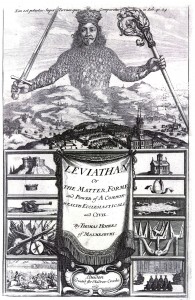Leviathan by Thomas Hobbes.jpg. Digital image. Wikipedia. N.p., 26 Feb. 2006. Web. 18 Oct. 2015.
Published in 1651, the political writings of Thomas Hobbes, Leviathan, was accompanied by the frontispiece by Abraham Bosse. The bottom half of the piece displays contrasting symbols of the balanced sovereign powers, the emblems on the left depict the monarch and on the right represent the church. In the centre is the Sovereign King that is composed of citizens who are looking towards the head. The art piece was inspired by the anamorphic art form which originates from the Renaissance. The 1600s was the Baroque era, elaborate, realistic and precise art work was deemed as beautiful. Baroque art is filled with dramatic shading and naturalistic landscapes, the frontispiece of Leviathan meets the requirements within the details, opposed to the image as a whole. There is an abundance of shading and preciseness but the piece displays each Baroque aspect with many images. The overwhelming complexity and intricacy does not represent the Baroque era.
The Sovereign King at the centre is not a realistic impression of the ideal king, due to the abstractness of the body The shading of the Sovereign King has caused the three dimensional effect to prove inconsistent, along with the proportionality of the hands to the head. To better depict the Sovereign King to symbolize protection of the state, with the ideals of secularism and ecclesiastical, the hands must be larger for they are present in the foreground. The landscape in front of the king is of skewed proportions and the city that is present, appears to be removed from the background. Thus creating an inaccurate scale between the countryside and city.
The symbols that represent the two sovereign powers embody the essence of Baroque the most for they are realistic and dramatically shaded. The iconic images of the crown and religion are accurately created, separately, they are of Baroque standards. Although the elements of the era are present, the frontispiece as a whole is not a perfect example of Baroque art.

